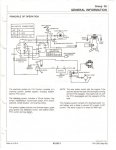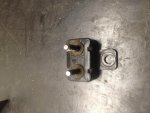I think Chance123 nailed it. Does this unit have a remote voltage regulator? It would be behind the instrument panel, probably mounted on the metal chassis. Looks like an aluminum heat sink. I'm not sure, but the diode may be part of that unit or near it (you may find it's called a "regulator/rectifier" which would indicate that the diode is internal - it is what rectifies the current, converting it from AC to DC). This might warrant involvement of a dealer diagnostic effort - if that's what is happening, you can fry stuff unexpectedly. You might hear that a bunch of stuff has to be replaced, not repaired *sigh* but let the dollars guide you on that, as your time is valuable too.
I have a John Deere GT242 that I repowered with a Briggs engine - and tangling with what should have been simple wiring issues humbled me in short order. At one point I thought everything was working fine, and then the computer card on the ignition switch burned up and I ended up having to rewire the whole thing from scratch. Stuff like that is hard to put up with at 11PM when its raining... just sayin.
By the way, consider that the fuel pump may be vacuum powered and not electrical. It would be a square unit about two inches across mounted somewhere on the side of the motor, fed (of course) by the fuel line. That's the most common configuration - my old Kawasaki single cyl. motor had that and my new Briggs v-twin replacement has the same thing. What you may have thought was a fuel pump wire may be instead a fuel solenoid wire - if so it would go directly to the carburetor. The fuel solenoid is a go/no go switch with a spring loaded plunger that interrupts the fuel flow. The idea is that while current is present, an electromagnet holds back the solenoid plunger and fuel can pass through the line to the carb. If current stops ( as when the engine is shut off) the plunger is no longer held back by the electromagnet and being spring loaded, extends like a finger into the fuel line, blocking fuel. Nice safety feature, and was originally designed (by Deere, I think) to keep fuel from seeping into the cylinder head when the unit was off - it was initially an anti-backfire device.
As a temporary measure, you could install a shutoff switch on one of the battery terminals (Tractor supply - about ten bucks) that disconnects the battery whenever the tractor is off. Might want to pick up a trickle charger though.


